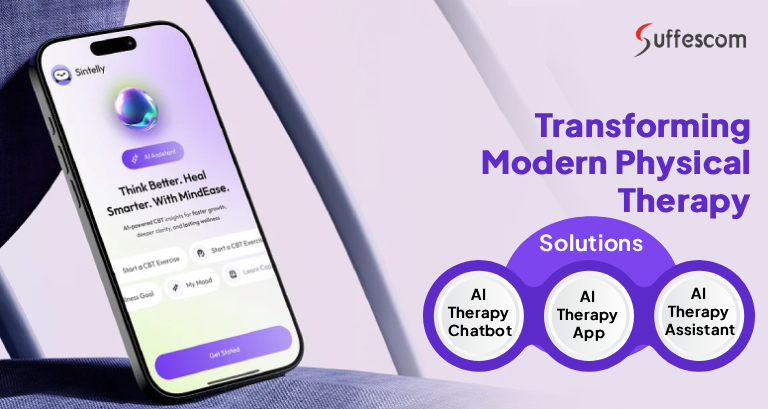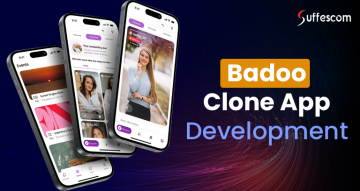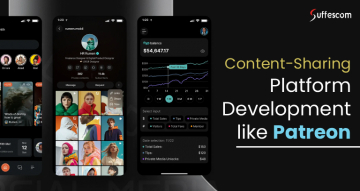AI Physiotherapy App Development: Transforming Modern Physical Therapy

Physiotherapy is a type of treatment that helps people move after an injury, illness, or chronic pain. It is done with the help of exercises, massages, or any physical activity without depending on drugs. But access to this service is not universal. Patients face many problems, such as long waiting lines, high costs, and a limited number of clinics providing such services. This leads to delayed and slower recovery.
Here comes the AI physiotherapy app development that makes its access easy for the patients. This progressive solution is actually changing the face of physical therapy as it helps to provide customized care remotely. As telehealth arrives, patients can now learn and receive treatment from the comfort of their own homes. This makes the therapy convenient and accessible.
The demand for such AI physiotherapy services is increasing. Actually, the global telerehabilitation market size was around $5.32 billion in 2024, which is expected to increase to $11.81 billion by 2030. This elevation clearly shows the growing preference for digital health solutions and the potential of AI that will usher in a new era of physiotherapy.
What Is an AI Physiotherapy App?
An AI physiotherapy app is a web or mobile app that assists individuals in performing therapy exercises at home with instructions from artificial intelligence. And, if needed, the option of human experts' intervention is there. A reliable AI development company like Suffescom could serve you with the best AI-integrated physiotherapy apps.
Here's what it typically does:
- Displays easy-to-follow exercise videos and instructions.
- Utilizes the camera or sensors to observe user movements.
- Provides real-time feedback regarding form and posture.
- Records progress over time.
- Allows users to connect with a physiotherapist if necessary.
Build Your AI Physical Therapy App Solution With Us
Don't let your clinic fall behind in the digital health revolution. Our AI physiotherapy app development provides you an edge in this domain.
Why Telephysiotherapy Application Development Is Gaining Momentum?
The world of physiotherapy is changing rapidly. There are many factors, like changed patient behaviors, emerging tech, and the desire for cost-saving measures, that are pushing the trend of AI physical therapy app development. Let's consider why this change is happening:
1. Increased acceptance of remote care
A couple of years ago, everyone used to like going to clinics for therapy. But post-pandemic, virtual consultations had become the new norm. Now, patients are more willing to do their physiotherapy sessions at home with digital platforms, so these days, telephysiotherapy apps have become a natural choice.
2. Increased access to smartphones
These days, almost everyone possesses a smartphone with an effective camera and internet access. This aids the process of providing AI-based physiotherapy without the need for special equipment. All patients have to do is download an app and begin their treatment from the comfort of their homes.
3. Advances in AI technology
Earlier, posture and movement analysis were required with costly equipment. Today, with AI and computer vision, mobile apps can perform this in real time with high accuracy. The technology is not only smarter but also much cheaper to implement.
4. Need for affordable care
Traditional physiotherapy can prove costly for patients when they have to attend multiple visits. These AI-based solutions allow clinics to limit the number of physical sessions while still offering quality care. Patients save money and time by practising physiotherapy at home.
5. Personalization at scale
Therapists often provide individualized plans for each patient, but they don't have time. AI apps enable automatic creation and modification of therapy programs for hundreds of users simultaneously. This provides a degree of personalization that is difficult to attain manually.
How an AI Physical Therapy App Works
If you hear the term AI physiotherapy app, it may seem complicated at first, but actually, it is quite a simple process. Here is a proper explanation of how it actually works:
1. Exercise Recognition and Tracking
2. Patient Assessment
Rather than going to a clinic, users do a few simple exercises or capture a short video. This provides the app with a reference point for their posture, movement, and pain spots.
3. AI Analysis
After the assessment, the app utilizes AI to examine the captured movements. It looks at angles, posture, and patterns to see if there are any problems that need to be worked on through therapy.
4. Personalized Plan
Based on the findings, the app produces a personalized exercise routine. It selects the appropriate exercises and intensity levels and makes sure the program suits the user's capabilities.
5. Guided Sessions
Users can get guided sessions in very easy to understand videos and on screen gestures. The app provides actual feedback, corrects flaws, and directs users to improve their forms as AI virtual health assistants.
6. Progress Tracking
A progress report is generated at the end of each session on its own. Users can view their progress over time through readable and understandable charts. It keeps them encouraged and assists therapists in tracking their rehabilitation.
7. Therapist Support
In the event that users require professional assistance, they can message or call their physiotherapist directly via the app. Such a combination of human assistance with AI makes for an ultimate therapy experience.
8. Adaptive Exercise Plans
Machine learning algorithms adjust the therapy program based on progress data. The more the user interacts, the smarter the system becomes — adapting intensity, duration, and type of exercises automatically.
9. Real-Time Feedback
The app provides instant feedback on form, alignment, and pace. If a user performs an exercise incorrectly, the AI alerts them and suggests corrections — much like a virtual physiotherapist.
10. Therapist Integration
The platform allows physical therapists to remotely monitor patients, modify routines, and communicate through secure chat or video consultations. This hybrid model ensures human expertise stays central.
Key Features to Include in AI Physical Therapy App Development
It requires a good foundation of core features for an AI physiotherapy app to really succeed in the real world. These are the cornerstones that make sure the experience is smooth and efficient:
1. User Profiles & Goals
An effective onboarding process ensures users can easily provide their health information and therapy goals. This information is the foundation to customize the therapy experience to suit each individual's requirements.
2. Exercise Library
A library of high-quality images and videos takes users through every exercise. When instructions are clear, users are more confident performing the movements alone.
3. Real-Time Feedback
By using the camera of the phone, the app provides real-time posture corrections. This prevents incorrect movement and optimizes users to get the maximum out of each session.
4. Notifications & Reminders
When having physiotherapy sessions, regularity is a must. It is important that users do not miss their sessions, and these smart notifications and reminders help them to remember.
5. Secure Messaging
Convenient communication between therapists and users fosters trust. It also makes it easy to clear doubts or seek feedback without taking additional appointments.
6. Therapist Dashboard
For professionals, having multiple patients monitored in one place saves time and also improves the quality of care. They can quickly review progress, update plans, and provide advice.
Launch Your Telephysiotherapy Platform with AI Power
From MVP to enterprise-level solutions, we provide end-to-end AI physiotherapy app development solutions.
Some Innovative and Advanced Features to Make Your Physiotherapy App Stand Out
Having basic features in your app is sufficient, but to stand out in the market, you have to add some extra and unique features to it so that these components improve the app's intelligence, usability, and engagement.
1. Adaptive Therapy Plans
Rather than following a predetermined schedule, the app can dynamically adjust exercises in real time as per the performance of users. The level goes up if they do well, and the strategy changes to try to catch up if they are falling behind.
2. Predictive Alerts
AI can identify indicators that a user may be losing consistency or experiencing issues. The app can then alert or notify the therapist in advance, avoiding recovery delay.
3. Wearable Integration
Integration of the app with wearables such as smartwatches or fitness bands allows the app to collect more precise movement data. This provides users and therapists with a better understanding of activity levels.
4. Gamification
Making therapy a game can increase motivation. Elements such as streaks, badges, or levels encourage users to keep returning, particularly younger patients.
5. AR Overlays
By using augmented reality, the app can literally project posture advice onto the screen in real time. It is like having your own AI personal health coach sitting next to you who is adjusting your form while you are in motion.
6. Multi-Language Support
Providing therapy in different languages welcomes a much larger population. People are at ease when instructions are given in their native language, which elevates their experience.
Traditional vs. AI Physiotherapy Apps: A Quick Comparison
There is so much competition in the market, so what you are bringing different from others on the table that matters. A quick comparison to show you the worth of AI physiotherapy apps:
| Aspect | Traditional Physiotherapy | AI Physiotherapy App |
| Location | Clinic-based | Can be used at home |
| Access | Fixed schedule, travel needed | 24/7 access from anywhere |
| Feedback | Therapist gives in person | AI provides real-time feedback |
| Scalability | Limited by staff | Can handle many users at once |
| Cost | Higher per session | More affordable, fewer visits |
| Personalization | Manual | Automated + therapist input |
AI Remote Physical Therapy App Development Process: We Follow
AI telephysiotherapy application development may sound difficult, but if you divide it into steps, it becomes much more manageable: We offer streamline AI powered remote telephysiotherapy app development process because this app deals directly with patient health, safety, and long-term recovery outcomes. Here’s why it should be robust and carefully executed:
1. Research & Discovery
Begin by knowing your audience and their issues. This research influences your whole strategy, from design to features, so you're creating something people actually need.
2. Consult Physiotherapists
Collaborating with actual therapists at an early stage is important. Their suggestions make your app adhere to correct medical procedures and gain the trust of users.
3. Design a Simple UI
The interface must be simple and minimalistic. Keep in mind that a lot of users may be old or injured, so the interface should render their experience smooth, not stressful.
4. Build the Core Features
Start with the basics, such as sign-up, exercise libraries, progress tracking, and teleconsultation. These all provide a solid foundation for the app.
5. Integrate AI Modules
Utilize trusted pose detection and motion analysis software to provide real-time feedback to users. This is where the "smart" in your app comes alive.
6. Set Up Backend & Database
A secure backend guarantees the privacy of data and seamless performance. It's the infrastructure that makes everything happen quietly in the background.
7. Connect Telehealth Tools
Adding video calls and AI therapy chatbots enables users to speak with physiotherapists at any time. This makes it a more holistic experience.
8. Test with Real Users
Prior to release, test with real patients and therapists. Their input assists you in stabilizing issues and enhancing usability.
9. Ensures Accuracy and Safety
AI analyzes body movements and gives exercise corrections in real time. Any flaws in development could lead to incorrect guidance, potentially worsening injuries. A strong process guarantees precise motion tracking, posture analysis, and safe exercise recommendations
10. Launch a Pilot
Start with a pilot project. A smaller user base, collect data, and iterate on the app. This process reduces risks and provides you with a clear path to scale.
11. Regular Improvement
We keep updating your app with improved features, smarter AI, and better performance. These ongoing improvements keep your product always ahead of others.
Tech Stack for Building Robust AI Physiotherapy App Solutions
Choosing the right technology for a project is like building its strong foundation. This helps to operate your app optimally, handle the data of users securely, and also advise correctly. Here are a few important tech stacks:
Frontend (User Side)
This is what people interact with — buttons, videos, dashboards.
- React Native / Flutter: They are perfect for creating cross-platform apps that function superbly on Android and iOS alike.
- HTML5, CSS3, JavaScript: If you are also building a web version, these are standard for creating smooth and responsive designs.
AI & ML Modules
This is what brings the most revolutionary change.
- TensorFlow / PyTorch: Powerful libraries used for pose detection, movement tracking, and exercise analysis.
- OpenPose / MediaPipe: Ideal for real-time posture correction and motion capture using just a smartphone camera.
- Custom ML Models: Personalisation is achieved through these models, which learn user habits and adjust therapy plans on their own.
Backend
The behind-the-scenes powerhouse driving the app.
- Node.js / Django: Robust frameworks for running logic, APIs, and data processing.
- PostgreSQL / MongoDB: For storing user information, therapy progress, and AI results securely.
- Firebase: Convenient for real-time updates and alerts.
Security & Compliance
Since it involves health data, security can't be a choice.
- HIPAA / GDPR compliance: Guarantees data is dealt with securely and legally.
- End-to-End Encryption: Ensures user-therapist conversations and health records are kept secret.
- Secure Cloud Hosting: AWS, Google Cloud, or Azure for robust performance and scalability.
Integration Tools
App connects easily with important services and devices.
- Telehealth APIs: For seamless video calls and live consultations.
- Payment Gateways: For simple subscription payments or one-time bookings.
- Wearable SDKs: For syncing data from fitness bands or smartwatches.
Cost of AI Physiotherapy App Development
Development costs for an AI Physiotherapy App can vary, depending on the complexity, some specific features, and the general scope of the app. A basic MVP solutions with core functionalities such as onboarding, exercise videos, scientific feedback, progress tracking, and teleconsultation usually costs $10,000, which is perfect for startups that want to test their idea. The cost will further increase as per the add-on functionalities and advancements.
Revenue Models for AI Physical Therapy App Solutions
To keep your app sustainable, you require an intelligent monetization model. The following are the most used models for AI Physical Therapy App Solutions:
1. Subscription Model
Customers pay a periodic fee to use therapy plans, AI functions, and support from therapists. It provides consistent revenue. It assists you in planning long-term updates and enhancements as well, because you have an idea of how many active subscribers you have.
2. In-App Purchases
In this, basic features are provided freely, but there is a charge for premium programs, advanced workouts, or wearable integrations. It provides the end users with the convenience of paying only for when and what they actually need, so your app will be perceived as fair and user-friendly.
3. Pay-Per-Consultation
The end-users pay only when they schedule a live consultation session with a physiotherapist. It's perfect for those who want flexibility. This is good for infrequent users who do not desire a subscription but still require professional assistance.
4. B2B Licensing
You can license your platform to clinics, hospitals, or gyms for their patients. This is a big way to get consistent revenue flows. The app will also appear as an expert tool, which will increase its credibility in the healthcare space.
5. Sponsored Content & Partnerships
You can partner with health product companies or fitness brands to offer them relevant tools within your app without weakening the trust of users. Strategic partnerships can benefit users while generating another source of income for your business.
Combining two or three models usually works best, balancing user happiness and steady revenue.
Transform Patient Care with AI Physiotherapy Today!
Partner with Suffescom to build your AI-powered physiotherapy solution and tap into the $11.81 billion telerehabilitation market.
Benefits of AI Physiotherapy App Development for Patients and Clinics
Investing in AI Physical Therapy App Development is not just about becoming digital—it offers tangible advantages to patients and healthcare professionals alike:
1. Accessibility
Everyone has access to therapy, regardless of location. It bypasses travel restrictions and opens up rural communities to quality care. Telephysiotherapy application development allows people who have mobility issues to keep getting therapy from their homes.
2. Convenience
Patients can attend their sessions at any time and from anywhere. They do not need to wait in the long lines at the clinic or for scheduling conflicts. It enables the user to follow a regular routine, and that's the most important aspect of quick recovery.
3. Savings
We know that less physical exposure means less expense for patients and less burden on clinics. With time, these savings can help make therapy accessible to more people.
4. Increased Engagement
Patients are more likely to remain consistent with their therapy routine if they have proper reminders and progress tracking. By gamifying or rewarding badges, sessions can be turned into games and maintained at a high level of enthusiasm.
5. Consistency & Accuracy
AI makes sure every exercise is adequately monitored. And AI therapeutic assistant development reduces human error and improves results. It allows therapists to track progress confidently, even when they are not physically there.
6. Informed Decisions
Clinics are able to improve their therapy plans, identify trends, and provide improved care using aggregated data. It also allows providers to build predictive models based on users’ data for more effective and efficient treatments.
Challenges in AI Physiotherapy App Development and How to Overcome Them
Although we have discussed many benefits, developing and operating AI physical therapy app solutions has its own set of challenges. What’s the silver lining? Each of them can be overcome cleverly.
1. Data Privacy Issues
We all know that our health information is very personal. The solution? Apply strict encryption, use HIPAA/GDPR compliance, and clearly inform users how their data is stored. Informing users about your privacy policies also gains trust and confidence in the application.
2. Internet Connectivity Issues
Not everyone possesses a stable internet connection. Providing offline capabilities or lower video quality can be a significant improvement. This prevents therapy from being disrupted, and users are not left behind because of low connectivity.
3. User Resistance
Certain users, particularly older users, might be reluctant to trust AI. A seamless onboarding process and voluntary support of therapists can facilitate confidence. Tutorial sessions or demo sessions in shorter durations can also introduce new users to the app.
4. Regulatory Compliance
Medical apps have strict regulations to abide by. Collaboration with legal professionals and obtaining certification early on prevents costly issues down the road. Documenting and having clean reporting mechanisms facilitates easy audits and inspections.
5. Accuracy of AI
Detection of poses needs to be accurate. Using established AI architectures and continuously training models on actual user data can improve accuracy over time. Constant updates and feedback loops mean the AI keeps on doing a good job as user patterns change.
Why Suffescom Is the Best Development Partner for AI Physiotherapy App Development
The selection of a suitable development partner is crucial to your project's success. We are a reliable healthcare app development company because we integrate sound technical acumen with actual healthcare know-how.
1. Time-tested AI Expertise: Our experts develop intelligent, scalable AI components that provide precise feedback and customized therapy experiences.
2. Domain Knowledge: We have developed several telehealth and physiotherapy products, so that we know what patients and therapists really need.
3. End-to-End Services: We do it all, from idea to market: design, development, compliance, testing, and support.
4. Security First: Health information is held in a secure cloud environment using encryption and HIPAA/GDPR regulations.
5. Scalable Solutions: Whether you’re launching a startup MVP or a large enterprise platform, our solutions are built to grow with you.
6. Global Reach: Our telephysiotherapy application development services are trusted by clients worldwide.
Revolutionize Recovery with Suffescom’s AI Physiotherapy App Solutions!
Physiotherapy does not need to be confined to the walls of clinics. A timetable or travel restrictions should not limit it. And with the right AI physical therapy app solutions, you can deliver expert care directly to people in their homes. It will be quicker, wiser and more personalized.
No matter whether you're seeking to create a patient-centric platform, a clinic application, or a complete telephysiotherapy platform, Suffescom can assist you in making your concept a reality.
FAQs
1. What do you mean by an AI physiotherapy app?
It is an AI and sensor-powered smartphone app that helps patients to have personalized physiotherapy exercises. It gives instant feedback and tracks users remotely. It basically works like having a virtual therapist with whom you can consult at any given moment, making recovery more flexible and convenient.
2. How does AI remote physical therapy app development work?
In this remote setup, patients receive physiotherapy plans on their phones. The virtual therapists can monitor the patient's progress and even offer support to them through chat or video calls. So, patients can request the therapy at home without compromising professional skills.
3. What are the most essential features of an AI physical therapy app that I must include?
The basic features are onboarding, exercise libraries, real-time feedback, progress tracking, teleconsultation, and a therapist dashboard. But if you add advanced features like adaptive plans or gamification, you can improve the app further and make it more engaging.
4. How much does it cost for an AI remote physical therapy app development?
AI physiotherapy app development cost generally ranges from $10,000 to $25,000. It keeps on rising as per the add-on features. But if you start with an MVP, you can reduce initial costs while testing the concept with real users.
5. What are the benefits of AI physiotherapy apps?
They offer accessibility, affordability, convenience, more accuracy, more engagement, and data-driven insights to users as well as clinics. Overall, they have the potential to improve recovery outcomes and make patients more enthusiastic in their path of recovery.
6. Which is the best company for developing AI physiotherapy apps?
Suffescom Solutions is the number one AI app development company because it has proven experience in telehealth, strong AI strengths, and end-to-end development services. We also keep your app up to date and secure, making it scalable as per growing user needs.







